Darcy Ogada
Nairobi, Kenya: 04 January 2024 — An international team of researchers has found that Africa’s birds of prey are facing an extinction crisis. The report, published January 4th in the journal, Nature Ecology & Evolution, warns of declines among nearly 90% of 42 species examined and suggests that more than two-thirds may qualify as globally threatened.
The study was co-led by Dr. Phil Shaw of the University of St. Andrews and Dr. Darcy Ogada of The Peregrine Fund. It combines counts from road surveys conducted within four African regions at intervals of c. 20–40 years, yielding unprecedented insights into patterns of change in the abundance of savanna raptor species.
It shows that large raptor species had experienced significantly steeper declines than smaller species, particularly on unprotected land, where they are more vulnerable to persecution and other human pressures. Overall, raptors had declined more than twice as rapidly outside of National Parks, Reserves, and other protected areas than they had within. Worryingly, many species suffering the steepest declines had suffered double jeopardy, having also become much more dependent on protected areas over the course of the study.
The study’s authors conclude that unless many of the threats currently facing African raptors are addressed effectively, large, charismatic eagle and vulture species are unlikely to persist over much of the continent’s unprotected land by the latter half of this century.
The study also highlights steep declines among raptors that are currently classified as being of ‘least concern’ in the global Red List of threatened species. They include African endemics such as Wahlberg's Eagle, African Hawk-eagle, Long-crested Eagle, African Harrier-hawk, and Brown Snake-eagle, as well as Dark Chanting-goshawk. All of these species have declined at rates suggesting that they may now be globally threatened.
Several other familiar, widespread raptor species are now scarce or absent from unprotected land. They include one of Africa’s most powerful raptors - the Martial Eagle - as well as the highly distinctive Bateleur.
Dr Phil Shaw commented: “Since the 1970s, extensive areas of forest and savanna have been converted into farmland, while other pressures affecting African raptors have likewise intensified. With the human population projected to double in the next 35 years, the need to extend Africa’s protected area network – and mitigate pressures in unprotected areas – is now greater than ever”.
Dr. Darcy Ogada said: “Africa is at a crossroads in terms of saving its magnificent birds of prey. In many areas, we have watched these species nearly disappear. One of Africa’s most iconic raptors, the Secretarybird, is on the brink of extinction. There’s no single threat imperiling these birds, it’s a combination of many human-caused ones, in other words, we are seeing deaths from a thousand cuts”.
Professor Ian Newton OBE FRS, FRSE, a world-leading ornithologist commented on the research: “This is an important paper which draws attention to the massive declines in predatory birds which have occurred across much of Africa during recent decades. This was the continent over which, only 50 years ago, pristine populations of spectacular raptors were evident almost everywhere, bringing excitement and wonder to visitors from many parts of the world. The causes of the declines are many – from rampant habitat destruction to growing use of poisons by farmers and poachers and expanding powerline networks – all ultimately due to expansions in human numbers, livestock grazing, and other activities. Let us hope that more research can be done and, more importantly, that these birds can be protected over ever more areas, measures largely dependent on the education and goodwill of local people.”
Raptors of all sizes lead an increasingly perilous existence on Africa’s unprotected land, where suitable habitat, food supplies, and breeding sites have been drastically reduced, and persecution from pastoralists, ivory poachers, and farmers is now widespread. Other significant threats include unintentional poisoning, electrocution on power poles, and collision with powerlines and wind turbines, as well as killing for food and belief-based uses.
The late Dr Jean Marc Thiollay laid the foundation for this study in the 1970s, by initiating a remarkable long-term monitoring effort in West Africa, where the average decline rate was more than twice that of other regions. The Peregrine Fund’s Dr Ralph Buij, who has re-surveyed some of the original areas, noted that: “the human footprint is particularly high throughout West Africa’s savannas, and the nearly complete disappearance of many raptors outside that region’s relatively small and fragmented protected area network reflects an ecological collapse that is increasingly affecting other parts of the continent. Some raptors that occur mostly in West Africa, such as the little-known Beaudouin’s Snake-eagle, are vanishing into oblivion.”
The study’s findings highlight the importance of strengthening the protection of Africa’s natural habitats and align with the Convention on Biological Diversity’s COP15 goal of expanding conservation areas to cover 30% of land by 2030. They also demonstrate the need to restore natural habitats within unprotected areas, reduce the impact of energy infrastructure, improve legislation for species protection, and establish long-term monitoring and evaluation of the conservation status of African raptors. Crucially, there is a pressing need to increase public involvement in raptor conservation efforts.
To this end, the study’s authors have developed the African Raptor Leadership Grant to address the immediate need for more research and conservation programs. It supports educational and mentoring opportunities for emerging African scientists, boosting local conservation initiatives and knowledge of raptors across the continent. This initiative, launched in 2023, awarded its first grant to Joan Banda, a raptor research student at AP Leventis Ornithological Research Institute in Nigeria, who will be studying threats to African owls.
Co-author Martin Odino of The Peregrine Fund and National Museums of Kenya noted that: “Poisoning, habitat loss, trapping, and persecution are but a few of the notorious threats that are decimating raptor populations. The severity of these threats is only exposed through long-term, meticulous scientific study. Real conservation action can only begin after education at the grassroots level to the top-most wildlife managers, only then do we stand a greater chance of adequately safeguarding raptors”.
Co-author Dr Munir Virani of the Mohamed Bin Zayed Raptor Conservation Fund said: “Dedicated conservation efforts can make a tangible impact toward reversing the alarming declines in bird of prey populations across sub-Saharan Africa. Our work in Mongolia involved insulating 27,000 power poles to prevent electrocution-related mortalities and has shown us that there are practical solutions to combat one of the major threats facing raptors. Together, similar success can be replicated in Africa, offering a beacon of hope for the future of these vital species and the ecosystems they support".
Co-author Dr. Umberto Gallo-Orsi, Head of the Coordinating Unit of the Memorandum of Understanding on the Conservation of Migratory Birds of Prey in Africa and Eurasia (Raptors MOU) added: “Under the Convention on Migratory Species (CMS), the Raptors MOU provides the institutional framework for governments and experts to address the many challenges that birds of prey are facing in Africa. The Signatory states of the Raptors MOU have identified almost 230 important raptor sites in Africa that need to be protected and conserved. Ensuring all these sites are well-connected and protected is vital to safeguard the future of our raptors and contributes to the 30 by 30 Biodiversity Framework Target”.







